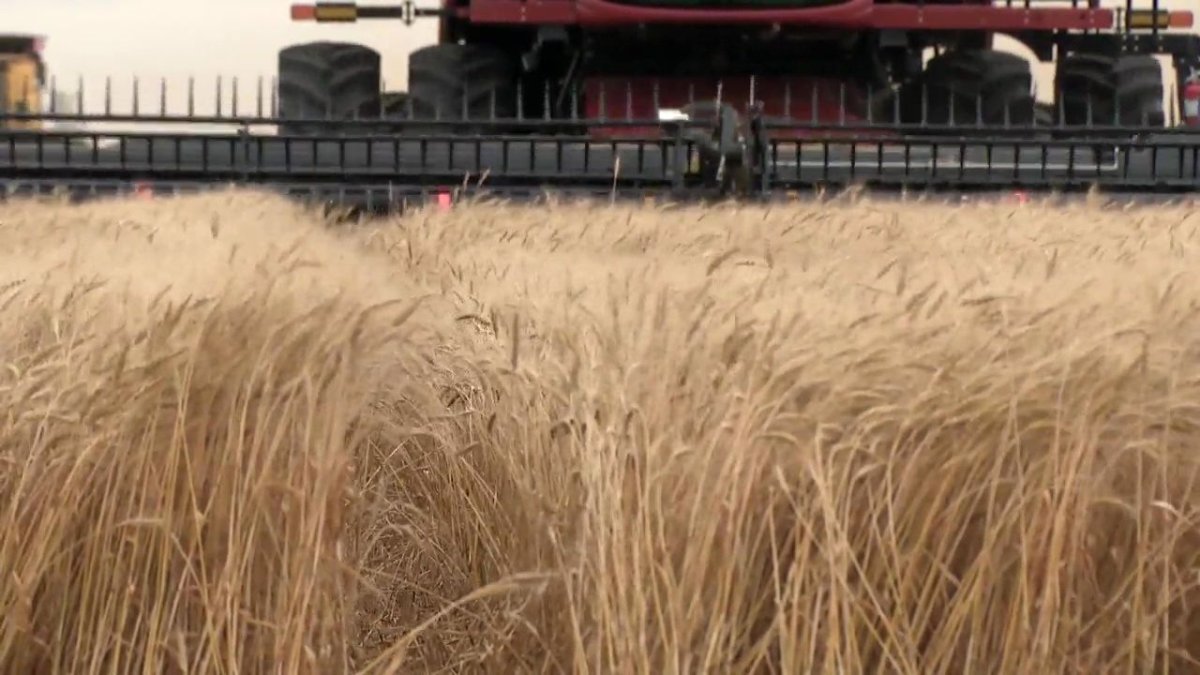The harvest in Saskatchewan is nearly at the three-quarter mark.

Saskatchewan Agriculture reported Thursday that 74 per cent of the crop has been combined, up from 56 per cent a week ago.
That is well above the five-year average of 50 per cent for this time of year.
Sask Ag said another 17 per cent of the crop is swathed or ready to straight-cut.
Warm and dry weather is needed to continue drying down crops and allow the harvest to continue without delay, according to the crop report.
Progress on the harvest comes as a report from Statistics Canada paints a picture on estimated field yields.
The harvested wheat area in the province is expected to fall 7.9 per cent to 11.8 million acres, StatCan reported Tuesday.
Yields are forecast to decrease 38.8 per cent to 28.1 bushels per acre, bringing total wheat production down 43.6 per cent year-over-year to 9.0 million tonnes.
It’s a similar story for canola production, according to StatCan.
Canola production in Saskatchewan is expected to decrease 47.2 per cent to 5.8 million tonnes.
- Train goes up in flames while rolling through London, Ont. Here’s what we know
- Budget 2024 failed to spark ‘political reboot’ for Liberals, polling suggests
- Wrong remains sent to ‘exhausted’ Canadian family after death on Cuba vacation
- Peel police chief met Sri Lankan officer a court says ‘participated’ in torture
The agency is projecting that lower yields of 21.2 bushels an acre — a decrease of 50.4 per cent — will offset 12.0 million acres of harvested areas — an increase of 6.3 per cent.
StatCan attributed the decline to ongoing drought conditions throughout the growing season and high temperatures during pollination.
Sask Ag said soil conditions across the province deteriorated in the past week due to a lack of moisture and strong winds.
Cropland topsoil moisture is rated at 36 per cent adequate, 38 per cent short and 26 per cent very short.
Hay and pasture land topsoil moisture are rated at 21 per cent adequate, 44 per cent short and 35 per cent very short.
The majority of crop damage this week was due to hail, wind and dry conditions, Sask Ag reported.
Frost was recorded in one RM in the northwest region. Ag officials said damage will vary depending on the temperature and duration of the frost as well as the stage of the crop.
They said that at this point in the season, the damage will likely be minimal as most crops are matured enough to withstand a minimal frost.
Relief measures
A number of relief measures have been announced for producers affected by the drought.
The 2021 Canada-Saskatchewan Drought Response Initiative will provide a per-head payment to livestock producers to help maintain female breeding stock.
The initial payment will provide producers $100 per breeding female equivalent in inventory as of Aug. 1, 2021.
Secondary payments of up to $100 per breeding female in inventory as of Dec. 31, 2021, will be made to producers who have incurred additional costs to retain the animals.
The Saskatchewan Crop Insurance Corp. is doubling the low yield appraisal threshold values for its customers who salvage their cereal or pulse crops as feed, without negatively impacting future individual coverage.
SCIC said customers should contact their local office first to discuss options before they graze, bale or silage any damaged crops.
The Saskatchewan government said it is providing relief to livestock producers by temporarily increasing the maximum funding from the Farm and Ranch Water Infrastructure program to $150,000 from $50,000.

The program is for dugouts, wells and pipelines for agriculture use, with the first $50,000 based on a 50-50 cost share and the remaining $100,000 on a 70-30 government-producer cost share.
More information on the program is available by contacting the Agriculture Knowledge Centre at 1-866-457-2377.
The federal and provincial governments have also increased the 2021 AgriStability interim benefit payment percentage from 50 per cent to 75 per cent for Saskatchewan producers.
The interim benefit provides the opportunity for producers enrolled in AgriStability to access a portion of their benefit early, to help support losses and cover costs.
Farmers stress line
Sask Ag said the Farmers Stress Line is available 24 hours a day for any needed support at 1-800-677-4442.
The service is run by Mobile Crisis Services Regina and all calls are confidential.




Comments